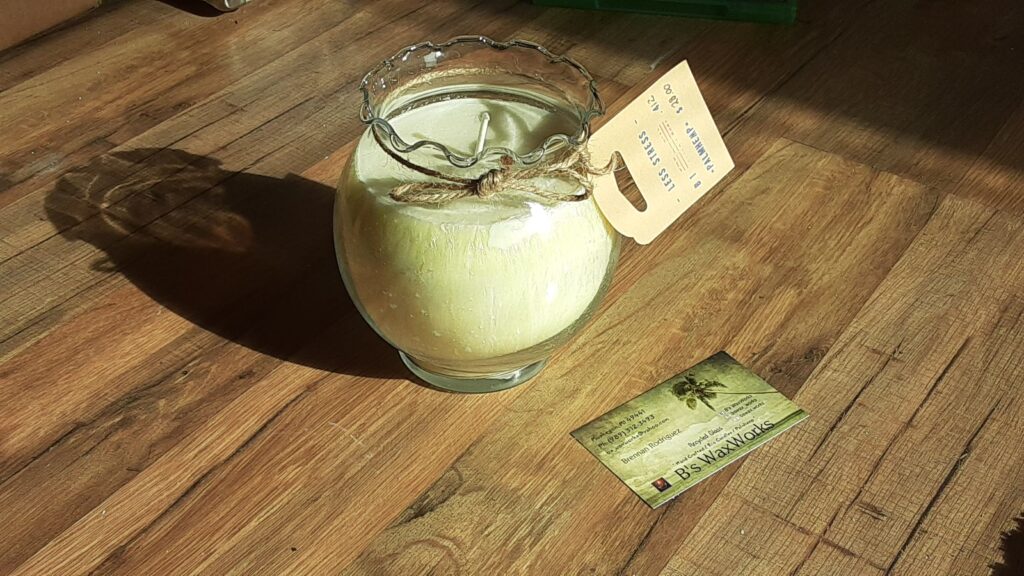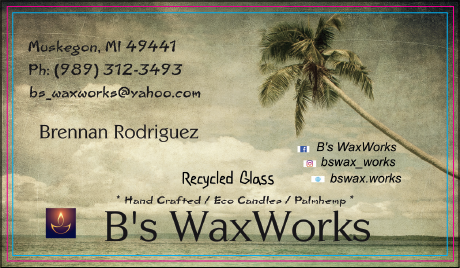What Defines a Quality Candle?
When you are on the hunt for the next fresh candle or the next cute décor add-on to your zen-den, you probably have: Scent, Presentation, Burn-time, and Price in Mind, but more and more people are starting to think about what goes INTO a quality candle.
So what does go into a quality candle? What do manufactures and craftspeople have to keep in mind when they are crafting a quality candle?
Like you, a quality crafter cares very much about the scent – so much, that they probably measure the scents to the fraction of an ounce when the candles are being planned and poured! TOO MUCH? Then your candles might sweat scents at the top of your candle OR WORSE….it might be toxic for the air quality. (Not a pretty sight.) TOO LITTLE? And you are left with a hunk of unscented wax (or pretty display piece – which some people actually prefer!)
So what’s the right amount? (That depends on the wax), “with B’s WaxWorks – PalmHemp Eco-blend Candles, about 10% of your candle weight is the fragrance!” This is the recommend fragrance level with their safety guidlines.
Picking a scent: Where is is being manufactured? What materials does that manufacture use when creating the fragrance? Does the live product smell like the description? These are the question a crafter brings to the discussion.
Beyond Scent? (The wicks, The Jars, The Wax, The Facts.)
While scents and fragrances might be the outer layer of your candle love, there is still much more that goes into a quality candle – THE WAX, is the next big item.
While traditional candles were initially made with Tallow, after the 1800s and the discovery of a coal based paraffin (legitimately oozing from coal), many candle manufactures switched to Paraffin. Reason? Paraffin was proven to be less harmful to air quality than Tallow candles. While the discovery of paraffin transformed the candle making industry for over a century, after the 2000s and the mass production of soy, it was soon discovered that a soy based waxes could be produced by a hydrogenation process and used in candle making.
SO what’s the big soy craze about? It goes without research that soy is not a petroleum extract, but beyond that, Soy burns clean – that is, soy has a white soot rather than a black soot that is almost guaranteed if your candle contains any amount of paraffin. With that, soy is not anymore “clean burning” them petroleum. Soy does clean a bit easier from the jar than most paraffin waxes, and has a higher heat tolerance and as a result, will last a bit longer than a paraffin candles.
With this being said….most soy candle makers still use a paraffin or palm wax as a stabilizing base for the candles and for a better scent throw when lit.
As for the Palmhemp blend wax in B’sWax Works candles, and palm wax in general: Palm wax comes with its own issues or struggles, from the high melting point, to the pouring – Palm wax can be very difficult to work with, and often takes multiple pour-overs to achieve the right cooling & hardening conditions.
(from last blog-post); Palm wax is collect and derived from the palm Fruit, ideally leaving the tree intact and making the full process environmentally friendly, BUT there is a very hot debate on the sustainability of Palm plantations and the collection processes for RSPO palm wax (Responsibly sourced palm oil). SOOO lets dig in:
There is no denying that Palm wax makes for the prettiest of candles, and when you see them, you’ll understand. Palm wax, when hardened at the right temperature takes on a crystalline formation lining most every inch of its container, including the top. Beyond the looks and due to the very high melting temperature of Palm wax, the candles last as long (if not longer) than its rivals. Whats the stink then?
As previously mentioned, many have seen the use of palm-wax and PALM OIL (difference) lead to de-forestation on a large scale and because of that, the sustainability aspect has been arguably interrupted.
Here is where I would Emphasis a vast majority of palm use is NOT for candles….rather its used for food products such as: Coffee Creamer, Coffer, Cookies, Muffins, Margarine, Cereals – (Non food: Lotions, Hair Products, Etc…)
Why emphasis the controversy? Because with enough influence in the market, there could be a push for more RSPO certified Palm plantations and more regulations on any palm company that might not be as environmentally conscious.
With increase awareness, increase influence, and persistance – Palm, could be the most environmentally friend source for candles. With Petrolum, there is a finite resource that takes millennia to form, vast amounts of energy expenditures for extraction and refining, with soy, a need for yearly replanting, harvest, and refining. With Palm, Ideally the fruit is used for the wax and oil extraction, and the tree is left safely to keep consuming carbon, while continuing to produce more workable material.
So Why Palmwax? – I believe it will be the best way to influence the Palm Market should the company gain movement.
Keep following to learn about the different wick materials that are used, why they are used, and how it affects the burn-time and quality of your candle!

A Quality Candle
